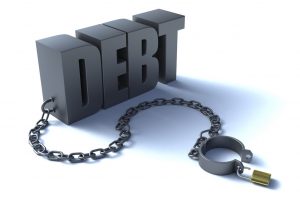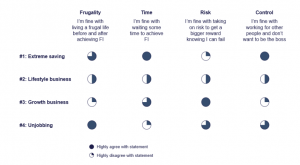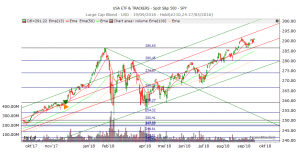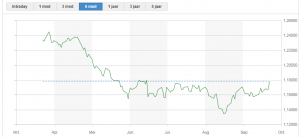 Collectively, Americans have more than $1 trillion in credit-card debt, according to the Federal Reserve. They have another $1.5 trillion in student loans, up from $1.1 trillion in 2013. Motor vehicle loans are now topping $1.1 trillion, up from $878.5 billion in 2013. And they have another nearly $15 trillion in mortgage debt outstanding. Many Americans did not benefit from economic growth and there is a lot of concern because the Great Recession isn’t that far in the rearview mirror.
Collectively, Americans have more than $1 trillion in credit-card debt, according to the Federal Reserve. They have another $1.5 trillion in student loans, up from $1.1 trillion in 2013. Motor vehicle loans are now topping $1.1 trillion, up from $878.5 billion in 2013. And they have another nearly $15 trillion in mortgage debt outstanding. Many Americans did not benefit from economic growth and there is a lot of concern because the Great Recession isn’t that far in the rearview mirror.So instead of buying a big house, the “American Dream” can just mean to aim for financial independence or security, living comfortably within your means, eliminate debt and being able to build wealth. I think that’s OK.
So in relation to topic Financial Independence, Carl from the blog MONEYMOW wrote out 4 ways to reach FI. Carl aims to retire when he is 33. Yes, you read this correctly…33 and that is in 6 years.
For those who never heard the “FI” concept, financial independence (FI) means that you have sufficient wealth to cover the expenses of your desired lifestyle without being dependent on income from traditional work (i.e. a monthly salary from employment at a company). It is considered an important goal for many people.
People who are financially independent usually have assets (e.g. stocks, bonds, real estate, businesses) that can generate an income equal to or higher than their expenses. This gives them the freedom to do whatever they want all the time without having to worry about money.
Carl describes the 4 strategies summarized in below infographic. So in this figure you can chose which strategy to apply depending on your attitude is towards frugality, time, control and risk. 
Which strategy should you choose to achieve financial independence? If you are not clear on what each strategy means, visit Carl’s blog by clicking the link. Carl follows the strategy of extreme saving. But please know that here’s not a single way to reach financial independence. I see many people around me executing different strategies. You can combine strategies, as I do, while trying to achieve FI, or make up your own strategy. Choosing a strategy is highly dependent on your personality and preferences.
Market Analysis
Last month we were writing about the longest bull run since years. Markets can clearly go up a lot longer than many people think they can. President Trump tweeted this today. New records of the S&P 500 are set !

When we analyse the performance of the SPY (screenshot 20 September) we can clearly see that the SPY has broken the All Time High level of 286, a line at 286.60. Resistance has been broken and we are riding the 13 Exponential Moving Average. Where is the next resistance level ? When we draw Fibonacci Retracements used by many traders, we see a level of 297,9$ on the SPY ETF. Let’s watch it in the coming month if we hit that level.

While tariffs on China keep on being added, the stock markets hardly react to the news anymore. Wall Street doesn’t seem to care about the escalating trade war between the United States and China. The Dow keeps on going higher each day. Investors are betting the US economy will continue to power ahead of the rest of the world. Yet beneath the surface, some are getting worried about the ability of the global economy to withstand the trade war and brewing storms in emerging markets. One in four professional investors is bracing for global growth to slow over the next year, according to a Bank of America Merrill Lynch survey published this week. That’s the worst outlook in this monthly survey since December 2011 and up from August when just 7% of investors were pessimists.
Also some prominent business leaders are starting to sound the alarm. The Business Roundtable, a powerful lobby led by JPMorgan Chase (JPM) boss Jamie Dimon, issued a statement saying that “unilaterally imposing tariffs is the wrong way to achieve real reforms” and threatens “further harm to US businesses and workers.”FedEx (FDX) CEO Fred Smith told analysts on Monday that the US-China trade fight is “worrisome to everyone” and may already be causing China’s economy to moderate. Alibaba (BABA) founder Jack Ma warned the US-China trade war could last for 20 years. “It’s going to last long, it’s going to be a mess,” Ma said this week. Early signs of worry, and I agree with those business leaders. Make sure you are prepared to make money in a stock market going down.
Let’s dive in the numbers of my August Passive Income Income Report.
My Passive Income in August 2018
In August 2018 we received a total of 472,44 $ passive income. We received only dividend income from our ETFs. STILL no options income but now we are completely transferred to our new broker. We are all set and ready for options trading. Too bad we did not hit the 500$ for the month.
Below you see the monthly summary overview of the cash flow coming into my bank account.
![]()
Portfolio Analysis and Growth
So far we have 5064,07$ passive income for the year 2018. Last year we received a lot more dividend income as we owned a lot of quarterly paying ETFs . We did NOT hit our monthly goal of 550$ per month.
![]()
We have 50% of our yearly objective in the books. We are way behind compared to last year but we are learning our mentor’s options investing strategy. We hope to execute soon this strategy.
The Euro/Dollar trend
 We keep on following the EURO/USD valuation. The Euro gained a little strength and bounced against the 1,18 resistance level, but I expect this to be short lived. As written in our blog post ” Seven Fat, Seven Skimmy Stock Market Years”, the expectation is that the dollar will get stronger over the midterm. But I can’t predict currencies either…lol.
We keep on following the EURO/USD valuation. The Euro gained a little strength and bounced against the 1,18 resistance level, but I expect this to be short lived. As written in our blog post ” Seven Fat, Seven Skimmy Stock Market Years”, the expectation is that the dollar will get stronger over the midterm. But I can’t predict currencies either…lol.
We will see how this EUR/USD price evolves over the coming months. A stronger dollar is always positive for our portfolio.
Going forward
The past month I have been learning the new platform and practicing with paper trading. I learn new capabilities of the platform and my mentor uses the same platform. That helps a lot. In the coming months I need to generate the remaining 5000$ ! Simple and straightforward goal. If we estimate that we receive 500$ per month in the remaining 4 months, then we receive a total of 2000$ dividend income. That means we need to generate 3.000$ in the coming three months. According to my mentor this is possible. But we will not do any crazy risks. Preserve your capital is rule number 1.
Are you working out investment strategies ? Don’t hesitate to leave your comments and feedback. Let us know what you think.
Good luck with your personal finance strategy! Thanks for following us on Twitter and Facebook and reading this blog post. As always we end with a quote.
Sources : Marketwatch, Yahoo Finance


No Comment
You can post first response comment.